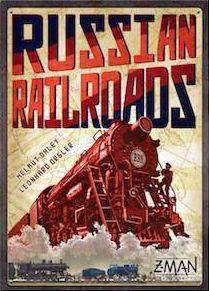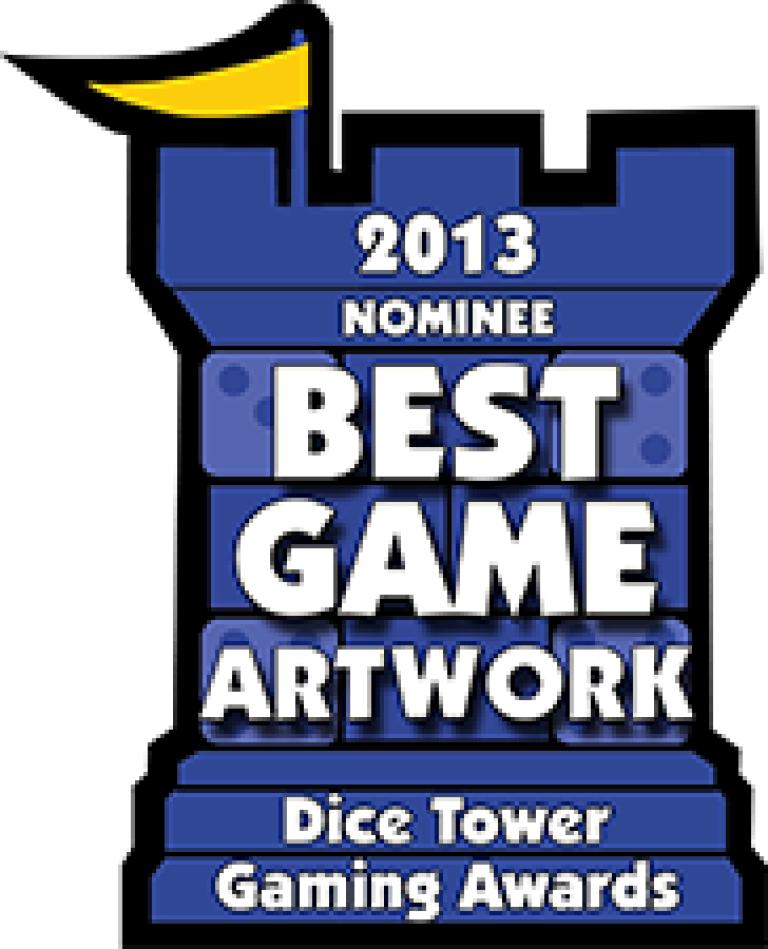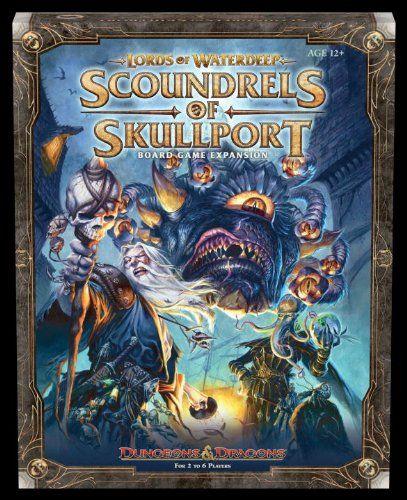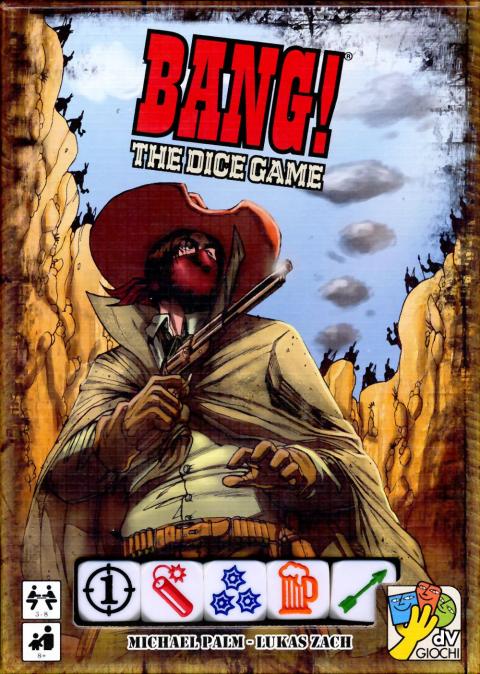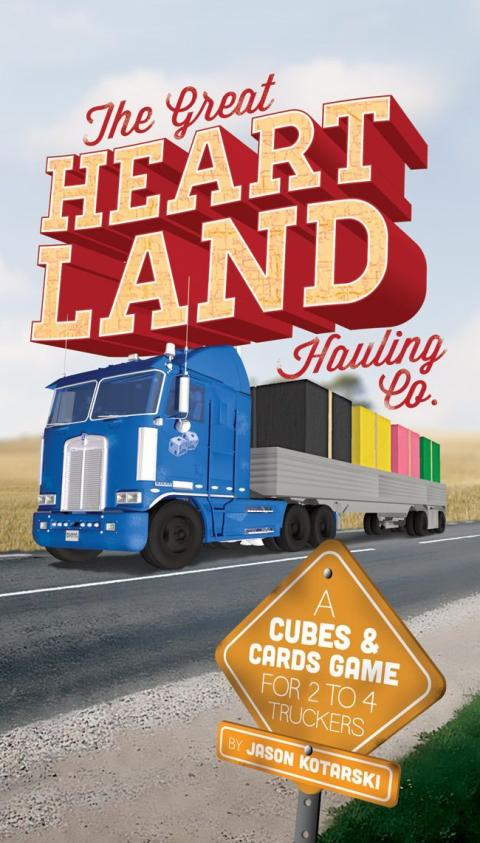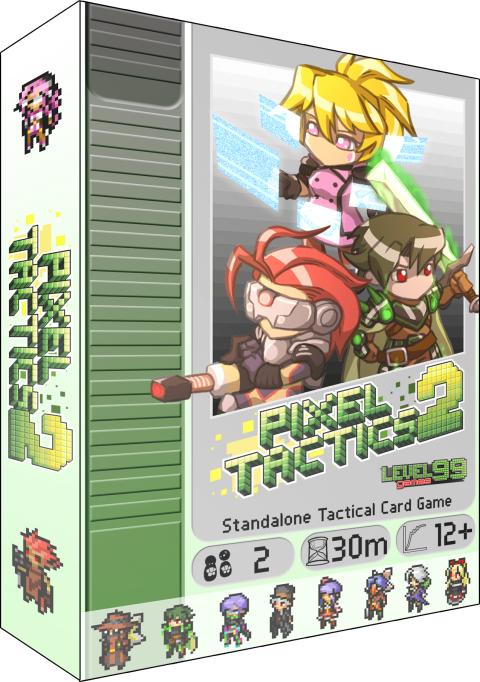Presenting the nominees of the seventh annual Dice Tower Awards for games released in 2013 in categories including artwork, small publisher, new designer, and the game of the year!
Game of the Year

Following along the same lines as its predecessor (Agricola), Caverna: The Cave Farmers is a worker-placement game at heart, with a focus on farming. In the game, you are the bearded leader of a small dwarf family that lives in a little cave in the mountains. You begin the game with a farmer and his spouse, and each member of the farming family represents an action that the player can take each turn. Together, you cultivate the forest in front of your cave and dig deeper into the mountain. You furnish the caves as dwellings for your offspring as well as working spaces for small enterprises.
It's up to you how much ore you want to mine. You will need it to forge weapons that allow you to go on expeditions to gain bonus items and actions. While digging through the mountain, you may come across water sources and find ore and ruby mines that help you increase your wealth. Right in front of your cave, you can increase your wealth even further with agriculture: You can cut down the forest to sow fields and fence in pastures to hold your animals. You can also expand your family while running your ever-growing farm. In the end, the player with the most efficiently developed home board wins.
You can also play the solo variant of this game to familiarize yourself with the 48 different furnishing tiles for your cave.
Caverna: The Cave Farmers, which has a playing time of roughly 30 minutes per player, is a complete redesign of Agricola that substitutes the card decks from the former game with a set of buildings while adding the ability to purchase weapons and send your farmers on quests to gain further resources. Designer Uwe Rosenberg says that the game includes parts of Agricola, but also has new ideas, especially the cave part of your game board, where you can build mines and search for rubies. The game also includes two new animals: dogs and donkeys.
It's up to you how much ore you want to mine. You will need it to forge weapons that allow you to go on expeditions to gain bonus items and actions. While digging through the mountain, you may come across water sources and find ore and ruby mines that help you increase your wealth. Right in front of your cave, you can increase your wealth even further with agriculture: You can cut down the forest to sow fields and fence in pastures to hold your animals. You can also expand your family while running your ever-growing farm. In the end, the player with the most efficiently developed home board wins.
You can also play the solo variant of this game to familiarize yourself with the 48 different furnishing tiles for your cave.
Caverna: The Cave Farmers, which has a playing time of roughly 30 minutes per player, is a complete redesign of Agricola that substitutes the card decks from the former game with a set of buildings while adding the ability to purchase weapons and send your farmers on quests to gain further resources. Designer Uwe Rosenberg says that the game includes parts of Agricola, but also has new ideas, especially the cave part of your game board, where you can build mines and search for rubies. The game also includes two new animals: dogs and donkeys.
Year Published:
2013
Designers:
Uwe Rosenberg
Publishers:
Lookout Games

Best Board Game Components
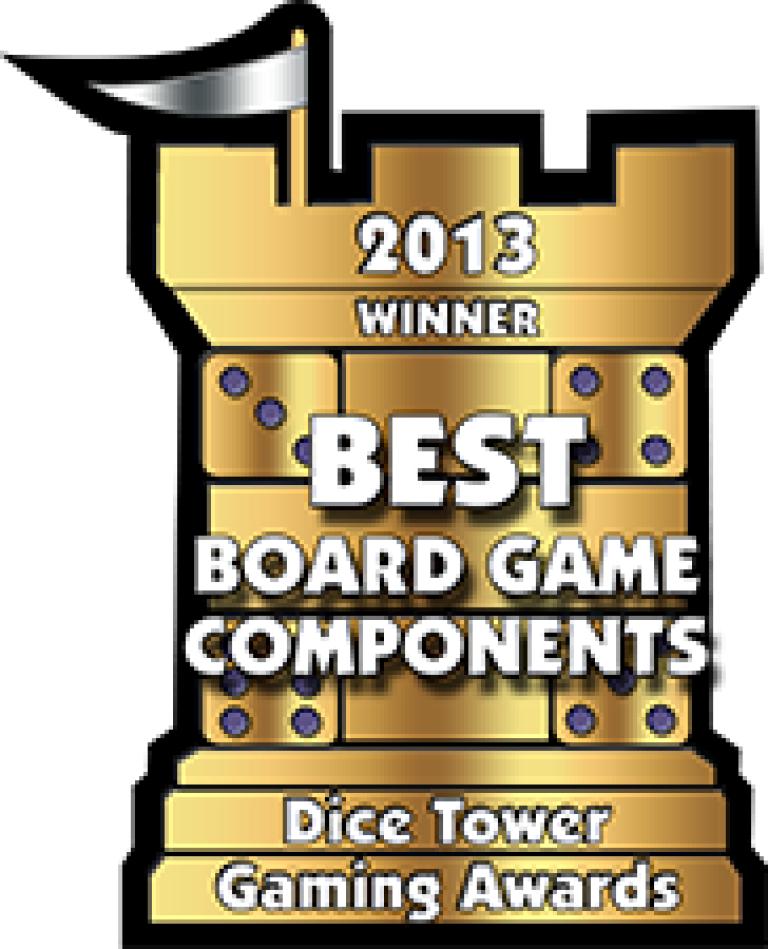
Game description from the publisher:
Prepare for fantasy battles beyond your wildest imagination with the onslaught of BattleLore Second Edition. Set in the fantasy realm of Terrinoth, BattleLore Second Edition is a two-player board game focused on squad-based battles between the hardy defenses of the Daqan Lords garrison in Nordgard Castle and the unleashed ferocity of the demon-worshipping Uthuk Y’llan. You must strategically command your troops and use the power of lore to tip your battles in your favor.
In every game, you will create new maps and scenarios, before mustering a new army for each game, so you can tailor your army to suit your favored play style. Command armies of fearsome warriors and deadly creatures, and lead them against the enemy in this intense game of warfare and military strategy. By seizing victory points from objectives on the battlefield and by eliminating enemy units, a skilled commander can raise his banners as the victor over the borderlands of Terrinoth!
BattleLore Second Edition comes with a game board, ninety-two detailed figures, forty-three map overlay pieces, more than one-hundred fifty cards, rules, four custom dice, and everything else you need to win the borderlands of Terrinoth!
Prepare for fantasy battles beyond your wildest imagination with the onslaught of BattleLore Second Edition. Set in the fantasy realm of Terrinoth, BattleLore Second Edition is a two-player board game focused on squad-based battles between the hardy defenses of the Daqan Lords garrison in Nordgard Castle and the unleashed ferocity of the demon-worshipping Uthuk Y’llan. You must strategically command your troops and use the power of lore to tip your battles in your favor.
In every game, you will create new maps and scenarios, before mustering a new army for each game, so you can tailor your army to suit your favored play style. Command armies of fearsome warriors and deadly creatures, and lead them against the enemy in this intense game of warfare and military strategy. By seizing victory points from objectives on the battlefield and by eliminating enemy units, a skilled commander can raise his banners as the victor over the borderlands of Terrinoth!
BattleLore Second Edition comes with a game board, ninety-two detailed figures, forty-three map overlay pieces, more than one-hundred fifty cards, rules, four custom dice, and everything else you need to win the borderlands of Terrinoth!
Year Published:
2013
Designers:
Richard Borg
Publishers:
Fantasy Flight Games
Best Co-op Game

Early in the history of the United States, slavery was an institution that seemed unmovable but with efforts of men and women across the country, it was toppled. In Freedom: The Underground Railroad, players are working to build up the strength of the Abolitionist movement through the use of notable figures and pivotal events. By raising support for the cause and moving slaves to freedom in Canada, the minds of Americans can be changed and the institution of slavery can be brought down.
Freedom is a card-driven, cooperative game for one to four players in which the group is working for the abolitionist movement to help bring an end to slavery in the United States. The players use a combination of cards, which feature figures and events spanning from Early Independence until the Civil War, along with action tokens and the benefits of their role to impact the game.
Players need to strike the right balance between freeing slaves from plantations in the south and raising funds which are desperately needed to allow the group to continue their abolitionist activities as well as strengthen the cause.
The goal is not easy and in addition to people and events that can have a negative impact on the group's progress, there are also slave catchers roaming the board, reacting to the movements of the slaves on the board and hoping to catch the runaway slaves and send them back to the plantations.
Through careful planning and working together, the group might see an end to slavery in their time.
Freedom is a card-driven, cooperative game for one to four players in which the group is working for the abolitionist movement to help bring an end to slavery in the United States. The players use a combination of cards, which feature figures and events spanning from Early Independence until the Civil War, along with action tokens and the benefits of their role to impact the game.
Players need to strike the right balance between freeing slaves from plantations in the south and raising funds which are desperately needed to allow the group to continue their abolitionist activities as well as strengthen the cause.
The goal is not easy and in addition to people and events that can have a negative impact on the group's progress, there are also slave catchers roaming the board, reacting to the movements of the slaves on the board and hoping to catch the runaway slaves and send them back to the plantations.
Through careful planning and working together, the group might see an end to slavery in their time.
Year Published:
2012
Designers:
Brian Mayer
Publishers:
Academy Games, Inc.
Best Family Game
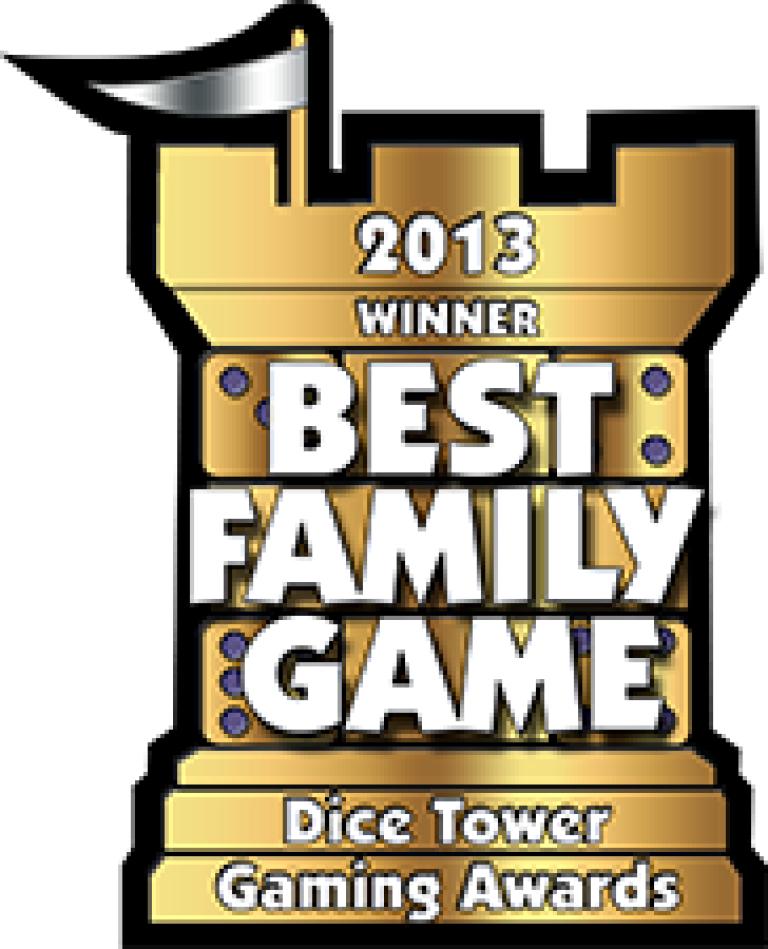
Game description from the publisher:
Gear up for a thrilling adventure to recover a legendary flying machine buried deep in the ruins of an ancient desert city. You'll need to coordinate with your teammates and use every available resource if you hope to survive the scorching heat and relentless sandstorm. Find the flying machine and escape before you all become permanent artifacts of the forbidden desert!
In Forbidden Desert, a thematic sequel to Forbidden Island, players take on the roles of brave adventurers who must throw caution to the wind and survive both blistering heat and blustering sand in order to recover a legendary flying machine buried under an ancient desert city. While featuring cooperative gameplay similar to Forbidden Island, Forbidden Desert is a fresh, new game based around an innovative set of mechanisms such as an ever-shifting board, individual resource management, and a unique method for locating the flying machine parts.
Gear up for a thrilling adventure to recover a legendary flying machine buried deep in the ruins of an ancient desert city. You'll need to coordinate with your teammates and use every available resource if you hope to survive the scorching heat and relentless sandstorm. Find the flying machine and escape before you all become permanent artifacts of the forbidden desert!
In Forbidden Desert, a thematic sequel to Forbidden Island, players take on the roles of brave adventurers who must throw caution to the wind and survive both blistering heat and blustering sand in order to recover a legendary flying machine buried under an ancient desert city. While featuring cooperative gameplay similar to Forbidden Island, Forbidden Desert is a fresh, new game based around an innovative set of mechanisms such as an ever-shifting board, individual resource management, and a unique method for locating the flying machine parts.
Year Published:
2013
Designers:
Matt Leacock
Publishers:
Gamewright
Best Artwork

Across the globe, ancient evil is stirring. Now, you and your trusted circle of colleagues must travel around the world, working against all odds to hold back the approaching horror. Foul monsters, brutal encounters, and obscure mysteries will take you to your limit and beyond. All the while, you and your fellow investigators must unravel the otherworldy mysteries scattered around the globe in order to push back the gathering mayhem that threatens to overwhelm humanity. The end draws near! Do you have the courage to prevent global destruction?
Eldritch Horror is a co-operative game of terror and adventure in which one to eight players take the roles of globetrotting investigators working to solve mysteries, gather clues, and protect the world from an Ancient One – that is, an elder being intent on destroying our world. Each Ancient One comes with its own unique decks of Mystery and Research cards, which draw you deeper into the lore surrounding each loathsome creature. Discover the true name of Azathoth or battle Cthulhu on the high seas.
While the tasks on these Mystery cards (along with the locations of otherworldly gates, menacing monsters, and helpful clues) will often inform both your travel plans and the dangers you confront, you can find adventure anywhere in the world...even where you least expect it. It is during the Encounter Phase of each turn that players resolve combat or, alternatively, build their investigators' personal stories by reading an encounter narrative from one of several types of Encounter cards. You might go head to head with a monster in Istanbul or find yourself in a tough spot with the crime syndicate in a major city. Maybe you will embark on an expedition to the Pyramids or research a clue you uncover in the unnamed wilderness. You may even find your way through a gate and explore a dimension beyond time and space.
Should you fail an encounter, the cost is steep. If you are fortunate, you will merely incur physical or mental trauma. However, you might also be compelled to take a Condition card, which represents a specific injury or restriction gained throughout your journey, such as a Leg Injury or Amnesia. You could find yourself getting in over your head to acquire assets and receive a Debt condition – or maybe you'll owe a favor to something far more insidious than a debt collector, and enter into a Dark Pact! Whatever your condition, you would be wise to find a resolution with haste; many conditions have a "reckoning effect" which, if triggered, ensure a much more sinister fate.
All the while, the arrival of the Ancient One approaches. Its malign influence is manifested in Eldritch Horror as you draw Mythos Cards, which govern the appearance of otherworldly gates, fearsome monsters, and other ominous elements. Mythos cards keep your investigators under pressure, introducing new threats, even as the arrival of the Great Old One draws nearer! Since the investigators draw a new Mythos card each round, they're certain to have their hands full battling foul creatures and following up on strange rumors, even as they work to solve their three all-important mysteries.
With twelve unique investigators, two hundred-fifty tokens, and over three hundred cards, Eldritch Horror presents an epic, world-spanning adventure with each and every game.
Eldritch Horror is a co-operative game of terror and adventure in which one to eight players take the roles of globetrotting investigators working to solve mysteries, gather clues, and protect the world from an Ancient One – that is, an elder being intent on destroying our world. Each Ancient One comes with its own unique decks of Mystery and Research cards, which draw you deeper into the lore surrounding each loathsome creature. Discover the true name of Azathoth or battle Cthulhu on the high seas.
While the tasks on these Mystery cards (along with the locations of otherworldly gates, menacing monsters, and helpful clues) will often inform both your travel plans and the dangers you confront, you can find adventure anywhere in the world...even where you least expect it. It is during the Encounter Phase of each turn that players resolve combat or, alternatively, build their investigators' personal stories by reading an encounter narrative from one of several types of Encounter cards. You might go head to head with a monster in Istanbul or find yourself in a tough spot with the crime syndicate in a major city. Maybe you will embark on an expedition to the Pyramids or research a clue you uncover in the unnamed wilderness. You may even find your way through a gate and explore a dimension beyond time and space.
Should you fail an encounter, the cost is steep. If you are fortunate, you will merely incur physical or mental trauma. However, you might also be compelled to take a Condition card, which represents a specific injury or restriction gained throughout your journey, such as a Leg Injury or Amnesia. You could find yourself getting in over your head to acquire assets and receive a Debt condition – or maybe you'll owe a favor to something far more insidious than a debt collector, and enter into a Dark Pact! Whatever your condition, you would be wise to find a resolution with haste; many conditions have a "reckoning effect" which, if triggered, ensure a much more sinister fate.
All the while, the arrival of the Ancient One approaches. Its malign influence is manifested in Eldritch Horror as you draw Mythos Cards, which govern the appearance of otherworldly gates, fearsome monsters, and other ominous elements. Mythos cards keep your investigators under pressure, introducing new threats, even as the arrival of the Great Old One draws nearer! Since the investigators draw a new Mythos card each round, they're certain to have their hands full battling foul creatures and following up on strange rumors, even as they work to solve their three all-important mysteries.
With twelve unique investigators, two hundred-fifty tokens, and over three hundred cards, Eldritch Horror presents an epic, world-spanning adventure with each and every game.
Year Published:
2013
Designers:
Corey Konieczka
Publishers:
Fantasy Flight Games
Best Expansion

Scoundrels of Skullport adds new content for Lords of Waterdeep. It’s not one, but two, complete expansions: the sprawling dungeon of Undermountain and the criminal haven of Skullport.
Each thrilling location has unique characteristics and offers new play options, including new Lords, Buildings, Intrigue, and Quest cards.
Owners of Lords of Waterdeep can use one or both of these new subterranean locations to add depth to their game experience. There’s also a new faction, the Gray Hands, so now a sixth player can join in the fun!
The Undermountain Module
Undermountain is a vast and multileveled dungeon beneath Mount Waterdeep that once served the crazed wizard Halaster as a site for magical experiments. Now it is a labyrinthine maze with few refuges for weary adventurers.
The rumored wealth of Undermountain entices adventurers to brave the mysteries and monsters beneath the City of Splendors. The risks and the rewards are greater for undertaking Quests that require more Gold and Adventurers.
The Skullport Module
Skullport—also known as the Port of Shadow—is nestled in the heart of Undermountain, deep below the streets of Waterdeep. It is a haven for nefarious crimes, underhanded deals, and back-alley murders. Those who visit Skullport do so at their own peril, for around every corner are new ways to make people disappear.
The Skullport module includes a new resource: Corruption. Unlike Adventurers and Gold, having Corruption in your tavern penalizes you at the end of the game.
Each Corruption token in your Tavern at the end of the game is worth negative Victory Points. The exact negative value depends on how much Corruption has been collected throughout the game; the more corrupt you and your fellow Lords are, the more Corruption hurts your score.
Each thrilling location has unique characteristics and offers new play options, including new Lords, Buildings, Intrigue, and Quest cards.
Owners of Lords of Waterdeep can use one or both of these new subterranean locations to add depth to their game experience. There’s also a new faction, the Gray Hands, so now a sixth player can join in the fun!
The Undermountain Module
Undermountain is a vast and multileveled dungeon beneath Mount Waterdeep that once served the crazed wizard Halaster as a site for magical experiments. Now it is a labyrinthine maze with few refuges for weary adventurers.
The rumored wealth of Undermountain entices adventurers to brave the mysteries and monsters beneath the City of Splendors. The risks and the rewards are greater for undertaking Quests that require more Gold and Adventurers.
The Skullport Module
Skullport—also known as the Port of Shadow—is nestled in the heart of Undermountain, deep below the streets of Waterdeep. It is a haven for nefarious crimes, underhanded deals, and back-alley murders. Those who visit Skullport do so at their own peril, for around every corner are new ways to make people disappear.
The Skullport module includes a new resource: Corruption. Unlike Adventurers and Gold, having Corruption in your tavern penalizes you at the end of the game.
Each Corruption token in your Tavern at the end of the game is worth negative Victory Points. The exact negative value depends on how much Corruption has been collected throughout the game; the more corrupt you and your fellow Lords are, the more Corruption hurts your score.
Year Published:
2013
Designers:
Chris Dupuis
Publishers:
Wizards of the Coast
Best Reprint

OGRE and its sequel G.E.V. are tactical ground combat games set in the not-so-distant future. In 2085 A.D., armored warfare continues - faster and deadlier than ever. Hovercraft, tanks and infantry slug it out with tactical nuclear devices. But the most feared weapon of all needs no human guidance. It's a giant cybernetic tank called the OGRE.
The basic OGRE game gives one player a force of infantry and armor, and a command post he must defend. The other player has only one unit - but it's an OGRE. It's an even match. Advanced games allow solitaire or multi-player action, with OGREs on both sides.
Microgame #1 in the Metagaming Microgames series, and the original release of Ogre. Origin of the Game: Ogre / G.E.V..
This is an entry on RPGG:
GURPS Ogre includes character and vehicle descriptions, a future timeline, a discussion of the world of the Ogres, and the Armor Unit Combat System, a quick way to resolve battles involving player characters and get back to the roleplaying!
The basic OGRE game gives one player a force of infantry and armor, and a command post he must defend. The other player has only one unit - but it's an OGRE. It's an even match. Advanced games allow solitaire or multi-player action, with OGREs on both sides.
Microgame #1 in the Metagaming Microgames series, and the original release of Ogre. Origin of the Game: Ogre / G.E.V..
This is an entry on RPGG:
GURPS Ogre includes character and vehicle descriptions, a future timeline, a discussion of the world of the Ogres, and the Armor Unit Combat System, a quick way to resolve battles involving player characters and get back to the roleplaying!
Year Published:
1977
Designers:
Steve Jackson (I)
Publishers:
Steve Jackson Games
Best Game Theming

Early in the history of the United States, slavery was an institution that seemed unmovable but with efforts of men and women across the country, it was toppled. In Freedom: The Underground Railroad, players are working to build up the strength of the Abolitionist movement through the use of notable figures and pivotal events. By raising support for the cause and moving slaves to freedom in Canada, the minds of Americans can be changed and the institution of slavery can be brought down.
Freedom is a card-driven, cooperative game for one to four players in which the group is working for the abolitionist movement to help bring an end to slavery in the United States. The players use a combination of cards, which feature figures and events spanning from Early Independence until the Civil War, along with action tokens and the benefits of their role to impact the game.
Players need to strike the right balance between freeing slaves from plantations in the south and raising funds which are desperately needed to allow the group to continue their abolitionist activities as well as strengthen the cause.
The goal is not easy and in addition to people and events that can have a negative impact on the group's progress, there are also slave catchers roaming the board, reacting to the movements of the slaves on the board and hoping to catch the runaway slaves and send them back to the plantations.
Through careful planning and working together, the group might see an end to slavery in their time.
Freedom is a card-driven, cooperative game for one to four players in which the group is working for the abolitionist movement to help bring an end to slavery in the United States. The players use a combination of cards, which feature figures and events spanning from Early Independence until the Civil War, along with action tokens and the benefits of their role to impact the game.
Players need to strike the right balance between freeing slaves from plantations in the south and raising funds which are desperately needed to allow the group to continue their abolitionist activities as well as strengthen the cause.
The goal is not easy and in addition to people and events that can have a negative impact on the group's progress, there are also slave catchers roaming the board, reacting to the movements of the slaves on the board and hoping to catch the runaway slaves and send them back to the plantations.
Through careful planning and working together, the group might see an end to slavery in their time.
Year Published:
2012
Designers:
Brian Mayer
Publishers:
Academy Games, Inc.

Best Game from a New Designer

Early in the history of the United States, slavery was an institution that seemed unmovable but with efforts of men and women across the country, it was toppled. In Freedom: The Underground Railroad, players are working to build up the strength of the Abolitionist movement through the use of notable figures and pivotal events. By raising support for the cause and moving slaves to freedom in Canada, the minds of Americans can be changed and the institution of slavery can be brought down.
Freedom is a card-driven, cooperative game for one to four players in which the group is working for the abolitionist movement to help bring an end to slavery in the United States. The players use a combination of cards, which feature figures and events spanning from Early Independence until the Civil War, along with action tokens and the benefits of their role to impact the game.
Players need to strike the right balance between freeing slaves from plantations in the south and raising funds which are desperately needed to allow the group to continue their abolitionist activities as well as strengthen the cause.
The goal is not easy and in addition to people and events that can have a negative impact on the group's progress, there are also slave catchers roaming the board, reacting to the movements of the slaves on the board and hoping to catch the runaway slaves and send them back to the plantations.
Through careful planning and working together, the group might see an end to slavery in their time.
Freedom is a card-driven, cooperative game for one to four players in which the group is working for the abolitionist movement to help bring an end to slavery in the United States. The players use a combination of cards, which feature figures and events spanning from Early Independence until the Civil War, along with action tokens and the benefits of their role to impact the game.
Players need to strike the right balance between freeing slaves from plantations in the south and raising funds which are desperately needed to allow the group to continue their abolitionist activities as well as strengthen the cause.
The goal is not easy and in addition to people and events that can have a negative impact on the group's progress, there are also slave catchers roaming the board, reacting to the movements of the slaves on the board and hoping to catch the runaway slaves and send them back to the plantations.
Through careful planning and working together, the group might see an end to slavery in their time.
Year Published:
2012
Designers:
Brian Mayer
Publishers:
Academy Games, Inc.
Best Party Game

No moderator, no elimination, ten-minute games.
One Night Ultimate Werewolf is a fast game for 3-10 players in which everyone gets a role: One of the dastardly Werewolves, the tricky Troublemaker, the helpful Seer, or one of a dozen different characters, each with a special ability. In the course of a single morning, your village will decide who is a werewolf...because all it takes is lynching one werewolf to win!
Because One Night Ultimate Werewolf is so fast, fun, and engaging, you'll want to play it again and again, and no two games are ever the same.
This game can be combined with One Night Ultimate Werewolf Daybreak.
One Night Ultimate Werewolf is a fast game for 3-10 players in which everyone gets a role: One of the dastardly Werewolves, the tricky Troublemaker, the helpful Seer, or one of a dozen different characters, each with a special ability. In the course of a single morning, your village will decide who is a werewolf...because all it takes is lynching one werewolf to win!
Because One Night Ultimate Werewolf is so fast, fun, and engaging, you'll want to play it again and again, and no two games are ever the same.
This game can be combined with One Night Ultimate Werewolf Daybreak.
Year Published:
2014
Designers:
Ted Alspach
Publishers:
Bézier Games
Best Game from a Small Publisher

You find yourself in a dystopian cityscape with a few workers at your disposal to make your mark on the world. Like most people in dystopian fiction, your workers are oblivious to their situation. This world is all they've ever known, and you may use them at your whim.
The world as we know it has ended, and in its place the city of Euphoria has risen. Believing that a new world order is needed to prevent another apocalypse, the Euphorian elite erect high walls around their golden city and promote intellectual equality above all else. Gone are personal freedoms; gone is knowledge of the past. All that matters is the future.
The Euphorians aren’t alone. Outside the city are those who experienced the apocalypse firsthand—they have the memories and scars to prove it. These Wastelanders have cobbled together a society of historians and farmers among the forgotten scrap yards of the past.
There is more to the world than the surface of the earth. Deep underground lies the hidden city of Subterra, occupied by miners, mechanics, and revolutionaries. By keeping their workers in the dark, they’ve patched together a network of pipes and sewers, of steam and gears, of hidden passages and secret stairways.
In Euphoria: Build a Better Dystopia, you lead a team of workers (dice) and recruits (cards) to claim ownership of the dystopian world. You will generate commodities, dig tunnels to infiltrate opposing areas, construct markets, collect artifacts, strengthen allegiances, and fulfill secret agendas.
Euphoria is a worker-placement game in which dice are your workers. The number on each die represents a worker's knowledge—that is, his level of awareness that he's in a dystopia. Worker knowledge enables various bonuses and impacts player interaction. If the collective knowledge of all of your available workers gets too high, one of them might desert you. You also have two elite recruit cards at your disposal; one has pledged allegiance to you, but the other needs some convincing. You can reveal and use the reticent recruit by reaching certain milestones in the game... or by letting other players unwittingly reach those milestones for you.
Your path to victory is paved with the sweat of your workers, the strength of your allegiances, and the tunnels you dig to infiltrate other areas of the world, but the destination is a land grab in the form of area control. You accomplish this by constructing markets that impose harsh restrictions of personal freedoms upon other players, changing the face of the game and opening new paths to victory. You can also focus on gathering artifacts from the old world, objects of leisure that are extremely rare in this utilitarian society. The dystopian elite covet these artifacts—especially matching pairs—and are willing to give you tracts of land in exchange for them.
Four distinct societies, each of them waiting for you to rewrite history. What are you willing to sacrifice to build a better dystopia?
The world as we know it has ended, and in its place the city of Euphoria has risen. Believing that a new world order is needed to prevent another apocalypse, the Euphorian elite erect high walls around their golden city and promote intellectual equality above all else. Gone are personal freedoms; gone is knowledge of the past. All that matters is the future.
The Euphorians aren’t alone. Outside the city are those who experienced the apocalypse firsthand—they have the memories and scars to prove it. These Wastelanders have cobbled together a society of historians and farmers among the forgotten scrap yards of the past.
There is more to the world than the surface of the earth. Deep underground lies the hidden city of Subterra, occupied by miners, mechanics, and revolutionaries. By keeping their workers in the dark, they’ve patched together a network of pipes and sewers, of steam and gears, of hidden passages and secret stairways.
In Euphoria: Build a Better Dystopia, you lead a team of workers (dice) and recruits (cards) to claim ownership of the dystopian world. You will generate commodities, dig tunnels to infiltrate opposing areas, construct markets, collect artifacts, strengthen allegiances, and fulfill secret agendas.
Euphoria is a worker-placement game in which dice are your workers. The number on each die represents a worker's knowledge—that is, his level of awareness that he's in a dystopia. Worker knowledge enables various bonuses and impacts player interaction. If the collective knowledge of all of your available workers gets too high, one of them might desert you. You also have two elite recruit cards at your disposal; one has pledged allegiance to you, but the other needs some convincing. You can reveal and use the reticent recruit by reaching certain milestones in the game... or by letting other players unwittingly reach those milestones for you.
Your path to victory is paved with the sweat of your workers, the strength of your allegiances, and the tunnels you dig to infiltrate other areas of the world, but the destination is a land grab in the form of area control. You accomplish this by constructing markets that impose harsh restrictions of personal freedoms upon other players, changing the face of the game and opening new paths to victory. You can also focus on gathering artifacts from the old world, objects of leisure that are extremely rare in this utilitarian society. The dystopian elite covet these artifacts—especially matching pairs—and are willing to give you tracts of land in exchange for them.
Four distinct societies, each of them waiting for you to rewrite history. What are you willing to sacrifice to build a better dystopia?
Year Published:
2013
Designers:
Jamey Stegmaier
Publishers:
Stonemaier Games
Best Stragety Game

In Russian Railroads, players compete in an exciting race to build the largest and most advanced railway network. In order to do so, the players appoint their workers to various important tasks.
The development of simple tracks will quickly bring the players to important places, while the modernization of their railway network will improve the efficiency of their machinery. Newer locomotives cover greater distances and factories churn out improved technology. Engineers, when used effectively, can be the extra boost that an empire needs to race past the competition.
There are many paths to victory: Who will ride into the future full steam ahead and who will be run off the rails? Whose empire will overcome the challenges ahead and emerge victorious?
Game Summary
Each player has their own board, with space for factories, and 3 rail tracks (to 3 different cities). On each track, use a track token to mark the progression of your rails (different colored marker for each type or rail). Some interesting twists:
- The different track types must be built in a specific order (black, gray, brown, natural, white). Later tracks may never be advanced further on the track than the earlier tracks.
- On each track, as the track head advances, you cross several thresholds that provide awards: the ability to start a new color of track, victory points, bonus tiles, etc.
- Each track line can have one (two for the first rail) engine(s) associated with it; the size of the loco(s) determines how far down the track you actually score VP.
The central board has (almost) all the locations for placing workers. Each location requires 1-3 workers (of one player; played all together). Players, who start the game with 5 workers (or 6 workers, in 2-3 player games), will take turns using a location. These provide a variety of abilities, for example:
- advance 1 or more track heads by 1-3 spaces
- acquire an engine or factory; engines are allocated to rail lines, while factories (the reverse side of the tile) are placed on your factory line.
- earn 2 coins
- take 2 temporary workers
- jump ahead in turn order
- acquire an engineer, which has a unique power and becomes a worker-placement location only for you
Each round ends when all players have passed on placing/using workers. Then, score VP for each track and factory line. On each track line, only spaces as far down the track as the loco level will score. Each track type scores VP for every space from its track head back to where the next color of track starts. Track types built earlier (e.g. black) score less/space than later tracks (e.g., white). On each factory line the position of the purple industry marker(s) show how many VP are scored.
After 7 rounds (or 6 rounds, in 2-3 player games), the game ends; most VP wins!
The development of simple tracks will quickly bring the players to important places, while the modernization of their railway network will improve the efficiency of their machinery. Newer locomotives cover greater distances and factories churn out improved technology. Engineers, when used effectively, can be the extra boost that an empire needs to race past the competition.
There are many paths to victory: Who will ride into the future full steam ahead and who will be run off the rails? Whose empire will overcome the challenges ahead and emerge victorious?
Game Summary
Each player has their own board, with space for factories, and 3 rail tracks (to 3 different cities). On each track, use a track token to mark the progression of your rails (different colored marker for each type or rail). Some interesting twists:
- The different track types must be built in a specific order (black, gray, brown, natural, white). Later tracks may never be advanced further on the track than the earlier tracks.
- On each track, as the track head advances, you cross several thresholds that provide awards: the ability to start a new color of track, victory points, bonus tiles, etc.
- Each track line can have one (two for the first rail) engine(s) associated with it; the size of the loco(s) determines how far down the track you actually score VP.
The central board has (almost) all the locations for placing workers. Each location requires 1-3 workers (of one player; played all together). Players, who start the game with 5 workers (or 6 workers, in 2-3 player games), will take turns using a location. These provide a variety of abilities, for example:
- advance 1 or more track heads by 1-3 spaces
- acquire an engine or factory; engines are allocated to rail lines, while factories (the reverse side of the tile) are placed on your factory line.
- earn 2 coins
- take 2 temporary workers
- jump ahead in turn order
- acquire an engineer, which has a unique power and becomes a worker-placement location only for you
Each round ends when all players have passed on placing/using workers. Then, score VP for each track and factory line. On each track line, only spaces as far down the track as the loco level will score. Each track type scores VP for every space from its track head back to where the next color of track starts. Track types built earlier (e.g. black) score less/space than later tracks (e.g., white). On each factory line the position of the purple industry marker(s) show how many VP are scored.
After 7 rounds (or 6 rounds, in 2-3 player games), the game ends; most VP wins!
Year Published:
2013
Designers:
Helmut Ohley
Publishers:
Hans im Glück
Best Two-Player Game

Game description from the publisher:
Prepare for fantasy battles beyond your wildest imagination with the onslaught of BattleLore Second Edition. Set in the fantasy realm of Terrinoth, BattleLore Second Edition is a two-player board game focused on squad-based battles between the hardy defenses of the Daqan Lords garrison in Nordgard Castle and the unleashed ferocity of the demon-worshipping Uthuk Y’llan. You must strategically command your troops and use the power of lore to tip your battles in your favor.
In every game, you will create new maps and scenarios, before mustering a new army for each game, so you can tailor your army to suit your favored play style. Command armies of fearsome warriors and deadly creatures, and lead them against the enemy in this intense game of warfare and military strategy. By seizing victory points from objectives on the battlefield and by eliminating enemy units, a skilled commander can raise his banners as the victor over the borderlands of Terrinoth!
BattleLore Second Edition comes with a game board, ninety-two detailed figures, forty-three map overlay pieces, more than one-hundred fifty cards, rules, four custom dice, and everything else you need to win the borderlands of Terrinoth!
Prepare for fantasy battles beyond your wildest imagination with the onslaught of BattleLore Second Edition. Set in the fantasy realm of Terrinoth, BattleLore Second Edition is a two-player board game focused on squad-based battles between the hardy defenses of the Daqan Lords garrison in Nordgard Castle and the unleashed ferocity of the demon-worshipping Uthuk Y’llan. You must strategically command your troops and use the power of lore to tip your battles in your favor.
In every game, you will create new maps and scenarios, before mustering a new army for each game, so you can tailor your army to suit your favored play style. Command armies of fearsome warriors and deadly creatures, and lead them against the enemy in this intense game of warfare and military strategy. By seizing victory points from objectives on the battlefield and by eliminating enemy units, a skilled commander can raise his banners as the victor over the borderlands of Terrinoth!
BattleLore Second Edition comes with a game board, ninety-two detailed figures, forty-three map overlay pieces, more than one-hundred fifty cards, rules, four custom dice, and everything else you need to win the borderlands of Terrinoth!
Year Published:
2013
Designers:
Richard Borg
Publishers:
Fantasy Flight Games

Most Innovative Game
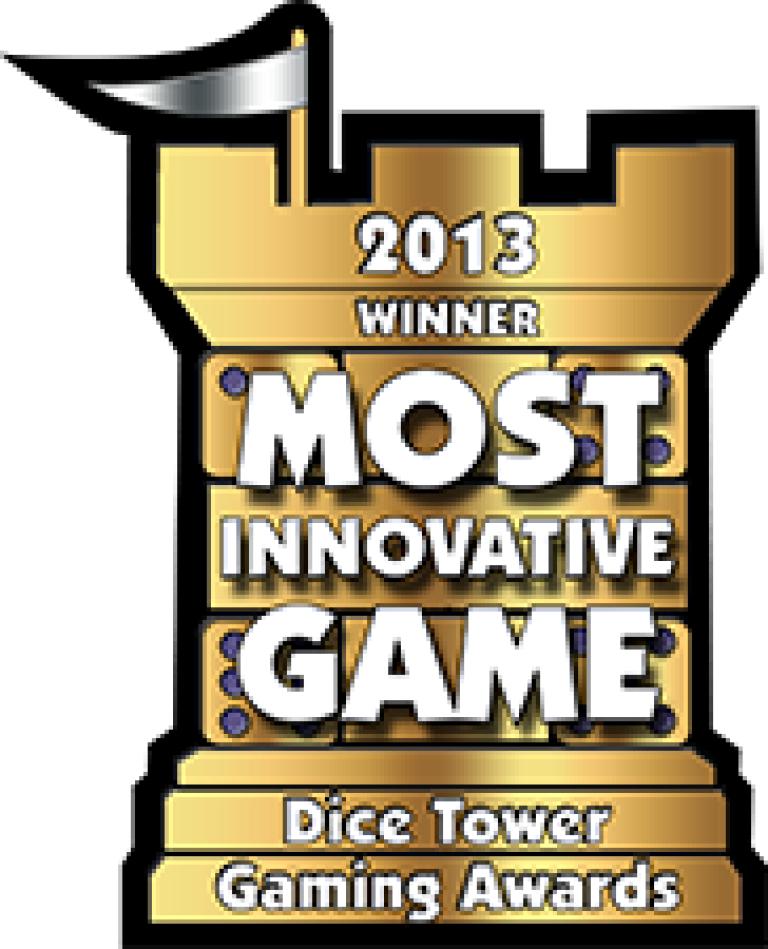
In Terror in Meeple City (formerly known as Rampage), you arrive in Meeple City as a gigantic, famished, scaly-skinned monster! Your goal: Dig your claws and dirty paws into the asphalt, destroy buildings, and devour innocent meeples – in short: sow terror while having fun. The monster who has caused the most damage after the carnage finally ends wins the game.
The buildings in Meeple City are comprised of floor tiles and meeples, with the meeples serving as pillars that support the floors. Four wooden vehicles are on the ground in the eight neighborhoods in the city. Each monster, which consists of a wooden paws disc and a wooden body, starts in one corner of the game board. On a turn you take two actions from four possibilities, repeating an action if desired:
Move: Pick up your monster body, flick the paws disc, then place the body back on the disc.
Demolish: If your paws are on the sidewalk surrounding a building, you can pick up your monster body, drop it onto a building, then collect any floors that have no meeples on them.
Toss a vehicle: If you're in a neighborhood with a vehicle, you can pick up the vehicle, place it on your body, then flick the vehicle at a building or another monster.
Breathe: Even while away from sidewalks with no vehicles, you can cause destruction by placing your chin on your monster's body and blowing across the board.
Monsters tend to be messy when obtaining meals, but if you knock meeples off the city board, you might be punished for letting food go to waste, costing you a tooth or letting other players take an additional action. After your two actions, you can eat unprotected meeples on the ground in your neighborhood, but you can eat only as many as the number of teeth you have. If you knock another monster to the ground, you break off one of its teeth, thereby keeping it from stealing your food! Meeples come in six colors, with the colors representing different types of inhabitants: blue (journalists), green (military), yellow (blondes), grey (old people), red (heroes), and black (businessmen). For each set of six you collect in your stomach, you score 10 points at game's end. You score points for collecting floors and teeth, too, and you can also score for achieving the goal on your character card.
In addition to the character card, each player has a power card and a superpower card unique to his monster, with the former lasting the entire game and the latter being a one-shot effect that's revealed only upon use.
Terror in Meeple City includes rules for monsters that evolve over the course of the game, that lose points for meeples not in sets, and that want to combine two game boards to allow for play with up to eight players.
The buildings in Meeple City are comprised of floor tiles and meeples, with the meeples serving as pillars that support the floors. Four wooden vehicles are on the ground in the eight neighborhoods in the city. Each monster, which consists of a wooden paws disc and a wooden body, starts in one corner of the game board. On a turn you take two actions from four possibilities, repeating an action if desired:
Move: Pick up your monster body, flick the paws disc, then place the body back on the disc.
Demolish: If your paws are on the sidewalk surrounding a building, you can pick up your monster body, drop it onto a building, then collect any floors that have no meeples on them.
Toss a vehicle: If you're in a neighborhood with a vehicle, you can pick up the vehicle, place it on your body, then flick the vehicle at a building or another monster.
Breathe: Even while away from sidewalks with no vehicles, you can cause destruction by placing your chin on your monster's body and blowing across the board.
Monsters tend to be messy when obtaining meals, but if you knock meeples off the city board, you might be punished for letting food go to waste, costing you a tooth or letting other players take an additional action. After your two actions, you can eat unprotected meeples on the ground in your neighborhood, but you can eat only as many as the number of teeth you have. If you knock another monster to the ground, you break off one of its teeth, thereby keeping it from stealing your food! Meeples come in six colors, with the colors representing different types of inhabitants: blue (journalists), green (military), yellow (blondes), grey (old people), red (heroes), and black (businessmen). For each set of six you collect in your stomach, you score 10 points at game's end. You score points for collecting floors and teeth, too, and you can also score for achieving the goal on your character card.
In addition to the character card, each player has a power card and a superpower card unique to his monster, with the former lasting the entire game and the latter being a one-shot effect that's revealed only upon use.
Terror in Meeple City includes rules for monsters that evolve over the course of the game, that lose points for meeples not in sets, and that want to combine two game boards to allow for play with up to eight players.
Year Published:
2013
Designers:
Antoine Bauza
Publishers:
Repos Production









